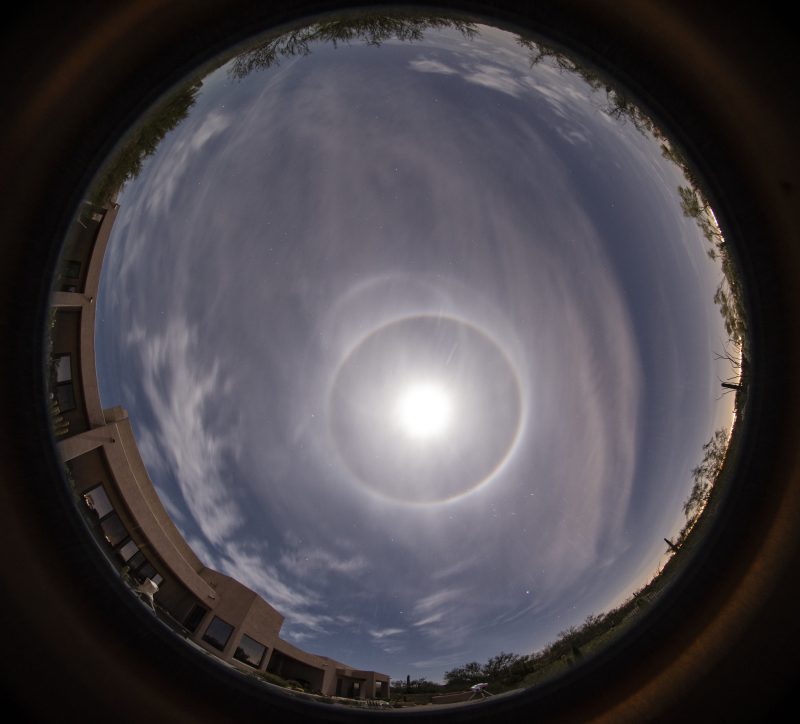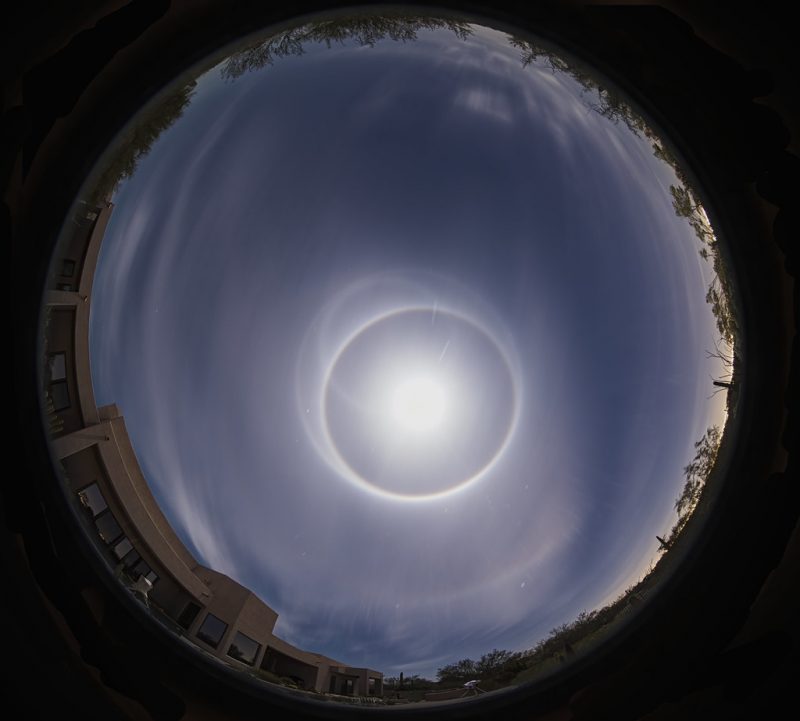
Rare moon halo photo captured during partial lunar eclipse
Eliot Herman in Tucson, Arizona – a veteran sky photographer and EarthSky community member – captured this extraordinary photo during the partial lunar eclipse on November 19, 2021. The photo of the moon shows an all-sky overhead view with one bright ring centered around the moon, a second ring that runs through the moon, and a set of arcs that connect the two. It’s incredibly rare to have all three phenomena appear together in one photo in this configuration.
On Flickr, Eliot described how he got the photo:
During lunar eclipse night, I used a fisheye to capture the entire sky. Tucson had clouds and haze, resulting in a lunar halo forming and disappearing. I was looking at the halo, cursing it at that moment because I was trying to photograph the eclipse. The moon was bright, and to my eye, the two fainter rings were not visible to me, with aging eyes. I was disappointed with the haze and clouds during the eclipse, but this certainly made lemonade out of the lemons.
Facts from Les Cowley
Atmospheric phenomena expert Les Cowley of the website Atmosphere Optics told Eliot:
This is rare … really rare. Congratulations Eliot.
The moon was high and the halo surrounding it is a circumscribed halo.
When the moon (or sun) is high, the halo is almost circular and often confused with the common 22 degree halo.
The smaller halo passing through the moon is a paraselenic circle, the lunar equivalent of a parhelic circle.
Both halos were made by hexagonal column ice crystals floating in cirrus with their long axes almost horizontal.
The fainter halo joining the other two is the really, really rare one. It is a Parry arc. That is rare enough. But only at the particular altitude of the moon when the camera fired does it touch both halos.
Parry arcs are generated by hexagonal column crystals that do not rotate about their long axes.
A unique photo!
Amazing job, Eliot! Thank you for sharing your photo. And thanks for the explanation, Les!
See Eliot’s photo page at EarthSky Community Photos
Visit Les Cowley’s website Atmospheric Optics

Bottom line: Eliot Herman in Tucson, Arizona, took a rare moon halo photo during the partial lunar eclipse on November 19, 2021.
Read more: What makes a halo around the sun or moon?
The post Rare moon halo photo, captured during lunar eclipse first appeared on EarthSky.
from EarthSky https://ift.tt/2ZirEkA

Rare moon halo photo captured during partial lunar eclipse
Eliot Herman in Tucson, Arizona – a veteran sky photographer and EarthSky community member – captured this extraordinary photo during the partial lunar eclipse on November 19, 2021. The photo of the moon shows an all-sky overhead view with one bright ring centered around the moon, a second ring that runs through the moon, and a set of arcs that connect the two. It’s incredibly rare to have all three phenomena appear together in one photo in this configuration.
On Flickr, Eliot described how he got the photo:
During lunar eclipse night, I used a fisheye to capture the entire sky. Tucson had clouds and haze, resulting in a lunar halo forming and disappearing. I was looking at the halo, cursing it at that moment because I was trying to photograph the eclipse. The moon was bright, and to my eye, the two fainter rings were not visible to me, with aging eyes. I was disappointed with the haze and clouds during the eclipse, but this certainly made lemonade out of the lemons.
Facts from Les Cowley
Atmospheric phenomena expert Les Cowley of the website Atmosphere Optics told Eliot:
This is rare … really rare. Congratulations Eliot.
The moon was high and the halo surrounding it is a circumscribed halo.
When the moon (or sun) is high, the halo is almost circular and often confused with the common 22 degree halo.
The smaller halo passing through the moon is a paraselenic circle, the lunar equivalent of a parhelic circle.
Both halos were made by hexagonal column ice crystals floating in cirrus with their long axes almost horizontal.
The fainter halo joining the other two is the really, really rare one. It is a Parry arc. That is rare enough. But only at the particular altitude of the moon when the camera fired does it touch both halos.
Parry arcs are generated by hexagonal column crystals that do not rotate about their long axes.
A unique photo!
Amazing job, Eliot! Thank you for sharing your photo. And thanks for the explanation, Les!
See Eliot’s photo page at EarthSky Community Photos
Visit Les Cowley’s website Atmospheric Optics

Bottom line: Eliot Herman in Tucson, Arizona, took a rare moon halo photo during the partial lunar eclipse on November 19, 2021.
Read more: What makes a halo around the sun or moon?
The post Rare moon halo photo, captured during lunar eclipse first appeared on EarthSky.
from EarthSky https://ift.tt/2ZirEkA

Aucun commentaire:
Enregistrer un commentaire